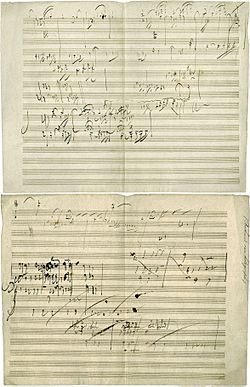Sonata facts for kids

Ludwig van Beethoven's own handwritten notes for his Piano Sonata No. 28, Movement IV. He finished this piece in 1816.
|
A sonata is a special type of music piece. It's usually played by one instrument, like a piano, or by one instrument with another one helping out, like a violin with a piano. The word "sonata" comes from Italy, and it means "to sound."
Composers can call almost any solo instrument piece a sonata. However, a sonata is usually a longer piece with several different parts, called "movements." A sonatina is like a sonata, but it's shorter and simpler.
Contents
The Story of Sonatas
Early Sonatas (16th to 18th Centuries)
The word "sonata" was first used in the 1500s. Back then, it just meant any music that was played by instruments, not sung.
In the Baroque period (from the 1600s to the early 1700s), many composers wrote sonatas. One famous composer was Arcangelo Corelli. These sonatas often had several movements. There were two main types:
- Sonata da camera: This means "room sonata" or "chamber sonata." These were played in people's homes. They usually had a harpsichord playing along.
- Sonata da chiesa: This means "church sonata." These were played in churches and often had an organ playing along.
Both types would also have a cello playing the low notes. The main instrument could be a violin, flute, recorder, or oboe.
Towards the end of the Baroque period, a composer named Domenico Scarlatti wrote over 500 sonatas just for the harpsichord! These were all short pieces with two main sections.
Sonatas in the Classical Period
By the time of the Classical period (from the mid-1700s to early 1800s), sonatas became longer. They usually had three or four movements.
- The first movement was typically fast.
- Then came a slow movement.
- The last movement was fast again.
If there were four movements, the extra one would be a minuet and trio or a scherzo. This extra movement could come before or after the slow movement. The first movement of a Classical sonata was almost always written in a special structure called sonata form.
The most important composers of sonatas during this time were Haydn, Mozart, and Beethoven.
Sonatas in Later Periods
Many composers in the Romantic period (1800s) continued to write sonatas. For example, Johannes Brahms wrote sonatas for piano alone, and also for violin and piano, cello and piano, and clarinet and piano.
In the 20th century, composers like Bartok, Michael Tippett, and William Walton also wrote sonatas, showing how this musical form kept changing and growing.
Related pages
See also
 In Spanish: Sonata para niños
In Spanish: Sonata para niños
Images for kids
-
Ludwig van Beethoven's manuscript sketch for Piano Sonata No. 28, Movement IV Geschwind, doch nicht zu sehr und mit Entschlossenheit (Allegro), in his own handwriting. The piece was completed in 1816.



